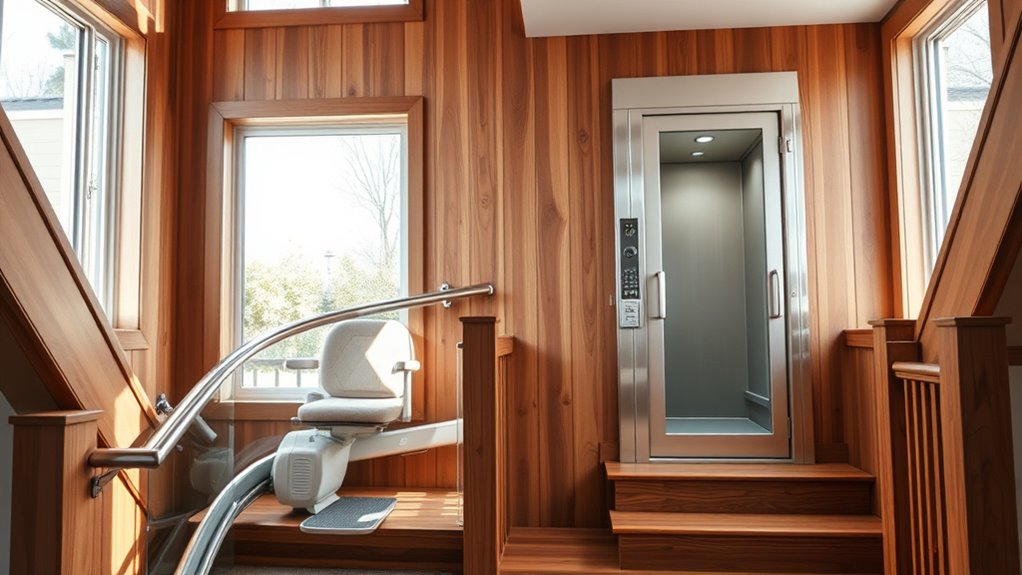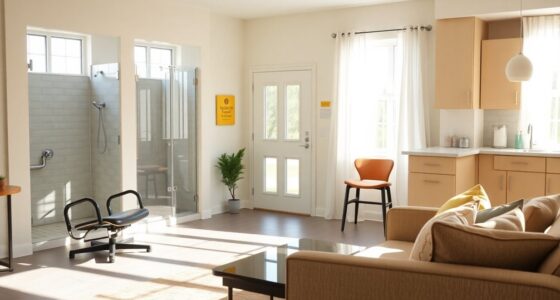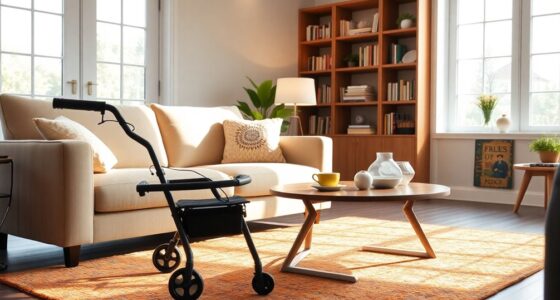When choosing between stairlifts and home elevators for senior mobility, consider your home’s layout, mobility needs, and budget. Stairlifts are quick to install, affordable, and work well on most staircases, making them a practical choice. Home elevators offer a more permanent, luxurious solution but require significant modifications and higher costs. To find out which option best suits you and how to make your home safer and more accessible, explore further details below.
Key Takeaways
- Stairlifts are quicker, easier to install, and require minimal structural changes compared to home elevators.
- Stairlifts suit most staircase types and space constraints, while elevators need dedicated shafts and more space.
- Both options include safety features; stairlifts have sensors and belts, elevators offer emergency controls and backups.
- Elevators provide a seamless, elegant look with customization options; stairlifts are practical for quick upgrades.
- Stairlifts are more affordable and suitable for short-term needs, whereas home elevators are a higher-cost, permanent solution.

Have you ever struggled with designing or building staircases that are both safe and stylish? When it comes to improving mobility in your home, especially for seniors, choosing the right solution is vital. Two popular options are stairlifts and home elevators, each offering different installation options and safety considerations. Understanding these aspects helps you make an informed decision that enhances safety without sacrificing aesthetics.
Stairlifts are generally quicker and simpler to install. They typically require minimal structural modifications, making them an attractive choice if you’re looking for a hassle-free upgrade. The installation options for stairlifts include attaching a sturdy rail system along the existing staircase, whether it’s straight or curved. This flexibility means you can adapt a stairlift to most staircase configurations with relative ease. Safety considerations are significant here; the rail system must be securely anchored to prevent any wobbling or detachment. Additionally, modern stairlifts come equipped with safety features like seat belts, obstacle sensors, and automatic seat return, ensuring the user remains safe throughout the ride. Proper maintenance and regular inspections are essential to keep these safety features functioning correctly over time. Moreover, the compatibility between the stairlift and the home’s electrical system is crucial to ensure reliable operation. Regular testing of safety features can help prevent accidents and maintain user confidence.
Stairlifts are quick, simple to install, and adaptable to various staircase types with essential safety features.
In contrast, home elevators involve more extensive installation options. They often require structural modifications, such as reinforcing the floor or creating a shaft within the home, especially if you opt for a hydraulic or traction-based elevator. These modifications can be more invasive and time-consuming but ultimately provide a seamless, luxurious mobility solution. The safety considerations for home elevators are equally critical. They usually feature emergency stop buttons, battery backups, and interlocking doors to prevent accidental falls or door openings when the elevator isn’t at the landing. Proper installation by qualified professionals is essential to guarantee all safety standards are met and that the elevator operates smoothly. Additionally, home automation systems can enhance safety and convenience when integrated with modern elevators, allowing for remote operation or monitoring. When considering installation environments, it’s important to evaluate space constraints to determine the most suitable mobility solution for your home.
While stairlifts are generally more affordable and quicker to install, home elevators offer a more permanent and aesthetically integrated solution. Safety features in both options are designed to protect users, but the choice depends on your home’s structure, budget, and long-term mobility needs. If you’re concerned about maintaining the style of your home, elevators can be customized to match your décor and provide a more discreet, elegant appearance. Conversely, stairlifts can be a practical and effective solution without major renovations, especially when space or structural limitations exist.
Ultimately, the decision hinges on your specific circumstances. Carefully weigh the installation options available and prioritize safety considerations to find the best fit for your home and loved ones. Both solutions aim to improve independence, but understanding their differences ensures you choose the safest, most effective mobility aid. Considering factors like cybersecurity vulnerabilities related to home automation and control systems can also be important when integrating these solutions into modern smart homes. Being aware of potential security risks ensures that your home remains safe and protected in all aspects.
Frequently Asked Questions
What Maintenance Is Required for Stairlifts and Home Elevators?
You should follow regular cleaning routines to keep your stairlift or home elevator in top shape, wiping down surfaces and checking for dust or debris. Also, guarantee electrical requirements are met, like inspecting wiring and outlets for safe operation. For stairlifts, lubricate the track periodically, while elevators may need professional inspections annually. Staying proactive with maintenance helps prevent malfunctions and keeps your mobility devices running smoothly.
How Do Installation Times Compare Between Stairlifts and Home Elevators?
When comparing installation times, stairlifts usually take just a few hours, causing minimal disruption to your home. In contrast, home elevators generally require several days or even weeks, depending on the complexity, with more significant renovation impact. You’ll find stairlifts are quicker to install, making them a convenient choice if you want a fast, less invasive solution for mobility needs.
Are There Any Safety Features Unique to Each Solution?
You’ll find safety features differ between stairlifts and home elevators. Stairlifts often include safety sensors that detect obstructions, preventing accidents, and an emergency stop button for immediate halting. Home elevators typically feature door interlocks, overload sensors, and backup power systems for safety during power outages. Both solutions prioritize your safety, but their unique features cater to different needs, giving you peace of mind in your mobility upgrade.
What Is the Typical Lifespan of Stairlifts Versus Home Elevators?
You might wonder about durability comparison and replacement costs for these solutions. Typically, stairlifts last around 8-10 years with proper maintenance, making them a cost-effective choice. Home elevators tend to have a longer lifespan of 20-25 years but require higher initial investment and replacement costs. Regular upkeep can extend their durability, so consider your budget and long-term needs when choosing between the two options.
Can These Solutions Be Customized to Fit Specific Home Layouts?
Imagine transforming your home to perfectly suit your needs—sounds incredible, right? Both stairlifts and home elevators offer impressive design flexibility and can be customized to fit your specific home layout. From narrow staircases to unique space constraints, professionals tailor these solutions to seamlessly blend with your decor. You won’t have to settle for generic options; instead, enjoy a personalized mobility upgrade designed just for your home.
Conclusion
When choosing between a stairlift and a home elevator, think about your mobility needs and home layout. For example, imagine Sarah, a senior with limited stairs, who installed a stairlift and regained independence, avoiding costly renovations. Whether you opt for a stairlift or an elevator, the right solution can restore your freedom and safety. Consider your future plans and consult a mobility expert to find the best fit. Your comfortable, accessible home is within reach.









